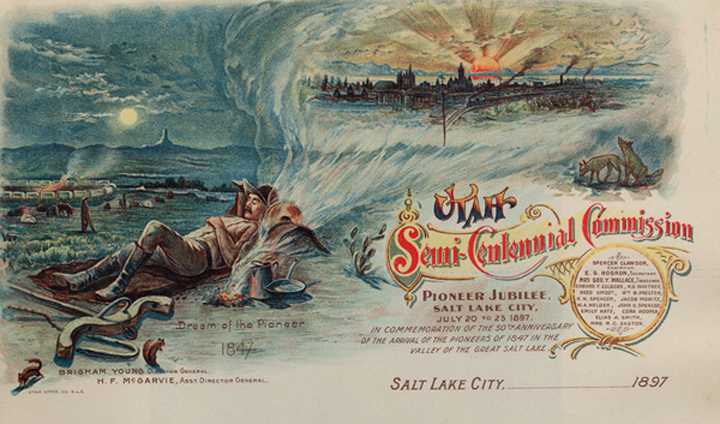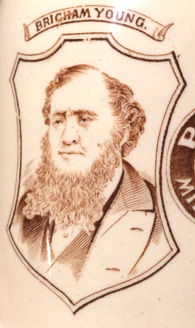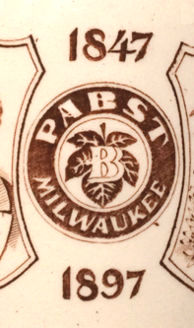Utah, Brigham Young and Beer
Provided by Roy DeSelms, Carolina Steiners
and Walt Vogdes, Pacific Stein Sammler

The featured stein for November is actually a mug. The design on the
mug is a transfer comprised of three separate images:
 A portrait of Brigham Young
A portrait of Brigham Young
 The logo of Pabst Brewing
Co, with the dates 1847-1897, indicating the 50th anniversary of Brigham Young's arrival in the Salt Lake Valley
The logo of Pabst Brewing
Co, with the dates 1847-1897, indicating the 50th anniversary of Brigham Young's arrival in the Salt Lake Valley
 A shield bearing the
immage of a bee hive celebrating the creation of the Utah Territory on September 9, 1850
A shield bearing the
immage of a bee hive celebrating the creation of the Utah Territory on September 9, 1850
Residents of Utah and collectors of American breweriana or Mormon
memorabilia will find obvious reason to be interested in this mug, but
other collectors may not find any special appeal—until they consider
the history and the seeming conflict between beer and the Mormon faith.
Brigham Young was the effective leader of the Church of Jesus Christ of
Latter-day Saints in Nauvoo, Illinois. In 1845 to address the growing
conflicts between his people and their neighbors, primarily involving
the practice of polygamy, Young agreed with Illinois Governor Thomas
Ford that the Mormons would leave by the following year. Young and the
first band of Mormon pioneers reached the Salt Lake Valley in 1847, a
location which was to become the hub of a "far-flung commonwealth" of
Mormon settlements.
The Mormon Church adheres to "The Word of Wisdom" which discourages
"strong drink" and wine, setting up a fundamental conflict with
alcoholic drink. Partly because of problems with bad water, early
Mormon settlers built breweries in the Salt Lake Valley almost as soon
the wagons were unpacked. The church disapproved of diverting valuable
resources to making alcohol — until it discovered passing gentiles who
were only too willing to pay hard cash for the stuff. Orrin Porter
Rockwell, the bodyguard to Brigham Young, is credited with starting the
first documented brewery in Utah at the Hot Springs Hotel and Brewery.
Despite their strictures against strong drink, the Mormons were happy
to profit from it.
In
what became known as the Wine Mission, European converts in the 1860s
put their viticultural expertise to work and produced 3,000 gallons of
wine a year in southern Utah. Brigham Young lauded their efforts: "I
anticipate the day when we can have the privilege of using, at our
sacraments, pure wine, produced within our borders."
Young himself said, “If I had the power, I would blow out the brains of
every thief in the territory, and I despise the whiskey maker more than
I do the thieves.” Young
claimed never to have tasted whiskey, and his
son-in-law William Hooper said, “Brigham Young hates intemperance and
its evils, and who, if he could have, would never have made a drop or
permitted a drop to enter Utah. He wishes that all the whiskey that the
Gentiles brought had been so filled with poison as to have killed all
who drank it.” That
said, in 1873 the territorial legislature granted Brigham Young the
exclusive
right to manufacture and distribute whiskey and other spirituous
liquors in Utah.
Despite his claims, Young generated a huge amount of
revenue for his new territory by taxing and controlling the very liquor
he manufactured, yet despised.
In 1895 as Utah's consitution was drafted, teetotalers wanted to
declare Utah a dry state. It took a while, but by 1911, Utah,
with the exception of Salt Lake City, Farmington, Ogden, Sandy,
Midvale, Price and various mining towns, was dry. In 1917 the
legislature acted to make Utah an entirely dry state and just two years
later Prohibition
was ratified by Congress; all four of Utah’s active breweries closed.
Salt Lake City Brewing and Becker Brewing changed their names and began
brewing nonalcoholic “Near Beer.”
In 1921, Heber J. Grant aligned church policy with the national
temperance movement and made absolute abstinence church law. The
culture of open warfare on demon rum is at least partly a legacy of
that alliance. Grant never forgot or forgave the rogue Utah Legislature
that very publicly thumbed its nose at his wishes and repealed
prohibition in 1933.
This mug was apparently produced for the Utah Pioneer Jubilee of
1897,
on behalf of Pabst Brewing. To celebrate the 50th anniversary of the
arrival of Brigham Young's wagon into the Salt Lake Valley, a
spectacular four-day celebration was planned to honor the surviving
pioneers. Only one year after Utah's statehood, organizers wanted the
Pioneer Jubilee to be “the biggest celebration in the country since the
1893 World’s Fair” and the largest event yet to be seen west of the
Mississippi. There can be little doubt that the survivors of the Mormon
trek from Illinois to Utah who were in attendance filled—and
emptied—many mugs of Pabst.

The Beer Stein Library has an entry in the Diesinger catalog for a souvenir stein with a Mormon/Brigham Young theme.

 Stein Collectors International
Stein Collectors International

 Stein Collectors International
Stein Collectors International

 A portrait of Brigham Young
A portrait of Brigham Young The logo of Pabst Brewing
Co, with the dates 1847-1897, indicating the 50th anniversary of Brigham Young's arrival in the Salt Lake Valley
The logo of Pabst Brewing
Co, with the dates 1847-1897, indicating the 50th anniversary of Brigham Young's arrival in the Salt Lake Valley A shield bearing the
immage of a bee hive celebrating the creation of the Utah Territory on September 9, 1850
A shield bearing the
immage of a bee hive celebrating the creation of the Utah Territory on September 9, 1850


